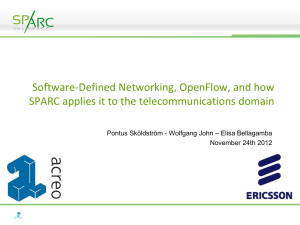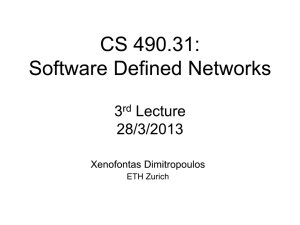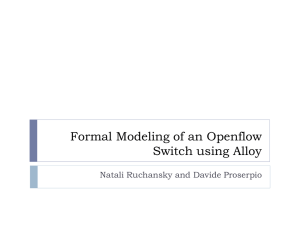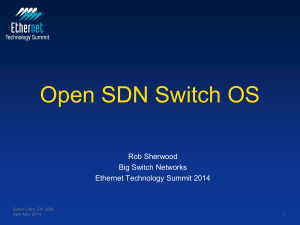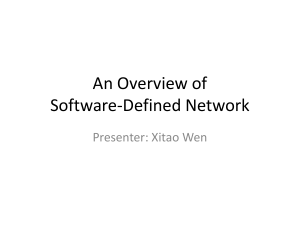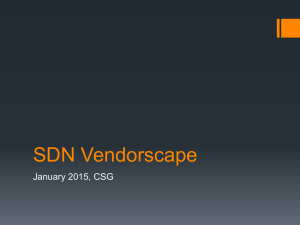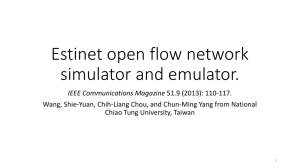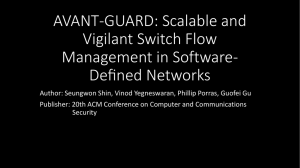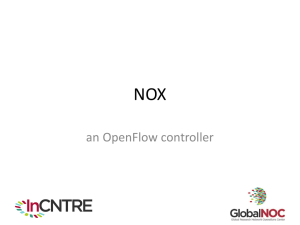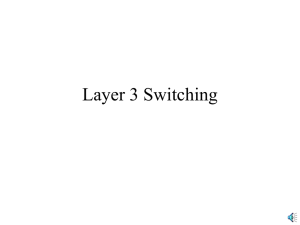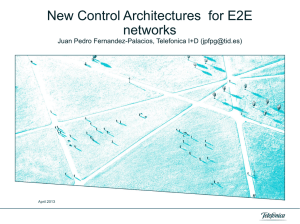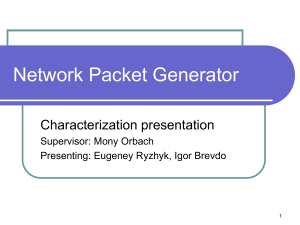Intro-SDN - CSE Labs User Home Pages
advertisement
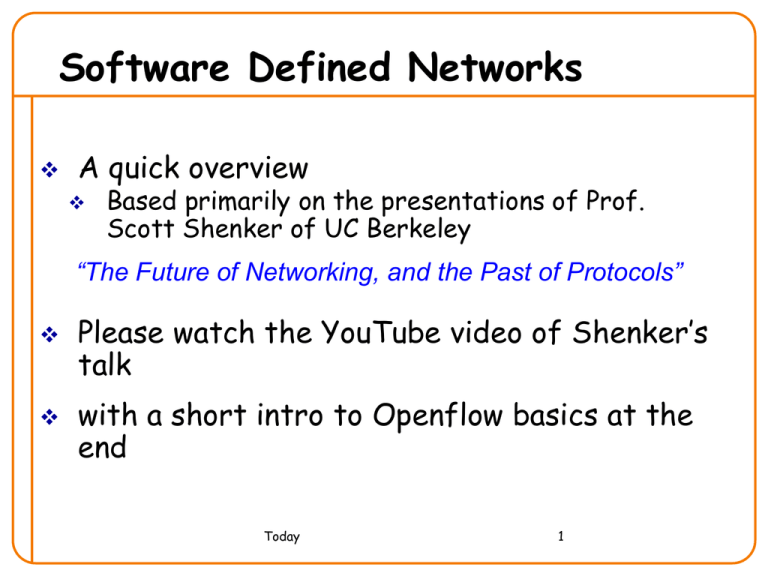
Software Defined Networks A quick overview Based primarily on the presentations of Prof. Scott Shenker of UC Berkeley “The Future of Networking, and the Past of Protocols” Please watch the YouTube video of Shenker’s talk with a short intro to Openflow basics at the end Today 1 Two Key Definitions • Data Plane: processing and delivery of packets – Based on state in routers and endpoints – E.g., IP, TCP, Ethernet, etc. – Fast timescales (per-packet) • Control Plane: establishing the state in routers – Determines how and where packets are forwarded – Routing, traffic engineering, firewall state, … – Slow time-scales (per control event) • These different planes require different abstractions 2 Limitations of Current Networks Switches 3 http://www.excitingip.net/27/a-basic-enterprise-lan-network-architecture-block-diagram-and-components/ Limitations of Current Networks • Enterprise networks are difficult to manage • “New control requirements have arisen”: –Greater scale –Migration of VMS • How to easily configure huge networks? 4 Limitations of Current Networks • Old ways to configure a network App App App Operating System App Specialized Packet Forwarding Hardware App App App App Operating System Specialized Packet Forwarding Hardware App Operating System App Specialized Packet Forwarding Hardware App App Operating System App App App Specialized Packet Forwarding Hardware Operating System Specialized Packet Forwarding Hardware OpenFlow/SDN tutorial, Srini Seetharaman, Deutsche Telekom, Silicon Valley Innovation Center 5 Limitations of Current Networks Feature Feature Operating System Specialized Packet Forwarding Hardware Million of lines of source code Billions of gates Many complex functions baked into infrastructure OSPF, BGP, multicast, differentiated services, Traffic Engineering, NAT, firewalls, … Cannot dynamically change according to network conditions 6 OpenFlow/SDN tutorial, Srini Seetharaman, Deutsche Telekom, Silicon Valley Innovation Center Limitations of Current Networks • No control plane abstraction for the whole network! • It’s like old times – when there was no OS… 7 Wilkes with the EDSAC, 1949 Idea: An OS for Networks Control Programs Network Operating System Simple Packet Forwarding Hardware Simple Packet Forwarding Hardware Simple Packet Forwarding Hardware Simple Packet Forwarding Hardware Simple Packet Forwarding Hardware OpenFlow/SDN tutorial, Srini Seetharaman, Deutsche Telekom, Silicon Valley Innovation Center 8 Idea: An OS for Networks Control Programs Network Operating System Simple Packet Forwarding Hardware Simple Packet Forwarding Hardware Simple Packet Forwarding Hardware Simple Packet Forwarding Hardware Simple Packet Forwarding Hardware OpenFlow/SDN tutorial, Srini Seetharaman, Deutsche Telekom, Silicon Valley Innovation Center 9 Idea: An OS for Networks • “NOX: Towards an Operating System for Networks” Software-Defined Networking (SDN) Control Programs Global Network View Network Operating System Control via forwarding interface Protocols Protocols 10 The Future of Networking, and the Past of Protocols, Scott Shenker, with Martin Casado, Teemu Koponen, Nick McKeown Software Defined Networking • No longer designing distributed control protocols • Much easier to write, verify, maintain, … –An interface for programming • NOS serves as fundamental control block –With a global view of network 11 Software Defined Networking • Questions: –How to obtain global information? –What are the configurations? –How to implement? –How is the scalability? –How does it really work? 12 A Short History of SDN ~2004: Research on new management paradigms • RCP, 4D [Princeton, CMU,….] • SANE, Ethane [Stanford/Berkeley] 2008: Software-Defined Networking (SDN) NOX Network Operating System [Nicira] OpenFlow switch interface [Stanford/Nicira] 2011: Open Networking Foundation (~69 members) • Board: Google, Yahoo, Verizon, DT, Msoft, F’book, NTT • Members: Cisco, Juniper, HP, Dell, Broadcom, IBM,….. 2012: Latest Open Networking Summit • Almost 1000 attendees, Google: SDN used for their WAN • Commercialized, in production use (few places) 13 The Future of Networking, and the Past of Protocols Scott Shenker 14 Key to Internet Success: Layers Applications …built on… Reliable (or unreliable) transport …built on… Best-effort global packet delivery …built on… Best-effort local packet delivery …built on… Physical transfer of bits 15 Why Is Layering So Important? • Decomposed delivery into fundamental components • Independent but compatible innovation at each layer • A practical success of unprecedented proportions… • …but an academic failure 16 Built an Artifact, Not a Discipline • Other fields in “systems”: OS, DB, DS, etc. - Teach basic principles - Are easily managed - Continue to evolve • Networking: - Teach big bag of protocols - Notoriously difficult to manage - Evolves very slowly 17 Why Does Networking Lag Behind? • Networks used to be simple: Ethernet, IP, TCP…. • New control requirements led to great complexity - Isolation - Traffic engineering - Packet processing middleboxes - Payload analysis - ….. VLANs, ACLs MPLS, ECMP, Weights Firewalls, NATs, Deep packet inspection (DPI) • Mechanisms designed and deployed independently - Complicated “control plane” design, primitive functionality - Stark contrast to the elegantly modular “data plane” 18 Infrastructure Still Works! • Only because of “our” ability to master complexity • This ability to master complexity is both a blessing… - …and a curse! 19 A Better Example: Programming • Machine languages: no abstractions - Mastering complexity was crucial • Higher-level languages: OS and other abstractions - File system, virtual memory, abstract data types, ... • Modern languages: even more abstractions - Object orientation, garbage collection,… Abstractions key to extracting simplicity 20 “The Power of Abstraction” “Modularity based on abstraction is the way things get done” − Barbara Liskov Abstractions Interfaces Modularity What abstractions do we have in networking? 21 Abstractions ~ Problem Decomposition Decompose problem into basic components (tasks) Define an abstraction for each component Implementation of abstraction can focus on one task If tasks still too hard to implement, return to step 1 22 Layers are Great Abstractions • Layers only deal with the data plane • We have no powerful control plane abstractions! • How do we find those control plane abstractions? • Two steps: define problem, and then decompose it. 23 The Network Control Problem • Compute the configuration of each physical device - E.g., Forwarding tables, ACLs,… • Operate without communication guarantees • Operate within given network-level protocol Only people who love complexity would find this a reasonable request 24 Programming Analogy • What if programmers had to: - Specify where each bit was stored - Explicitly deal with all internal communication errors - Within a programming language with limited expressability • Programmers would redefine problem: - Define a higher level abstraction for memory - Build on reliable communication abstractions - Use a more general language • Abstractions divide problem into tractable pieces - And make programmer’s task easier 25 From Requirements to Abstractions 1. Operate without communication guarantees Need an abstraction for distributed state 2. Compute the configuration of each physical device Need an abstraction that simplifies configuration 3. Operate within given network-level protocol Need an abstraction for general forwarding model Once these abstractions are in place, control mechanism has a much easier job! 26 1. Distributed State Abstraction • Shield control mechanisms from state distribution - While allowing access to this state • Natural abstraction: global network view - Annotated network graph provided through an API • Implemented with “Network Operating System” • Control mechanism is now program using API - No longer a distributed protocol, now just a graph algorithm - E.g. Use Dijkstra rather than Bellman-Ford 27 Network ofDefined Switches and/or Routers Software Network (SDN) Traditional Control Mechanisms e.g. routing, access control Control Program Global Network View Distributed algorithm running between neighbors Network OS 28 Major Change in Paradigm • No longer designing distributed control protocols - Design one distributed system (NOS) - Use for all control functions • Now just defining a centralized control function Configuration = Function(view) • If you understand this, raise your hand. 29 2. Specification Abstraction • Control program should express desired behavior • It should not be responsible for implementing that behavior on physical network infrastructure • Natural abstraction: simplified model of network - Simple model with only enough detail to specify goals • Requires a new shared control layer: - Map abstract configuration to physical configuration • This is “network virtualization” 30 Simple Example: Access Control What Abstract Network Model Global Network View How 31 Software Defined Network: Take 2 Abstract Network Model Network ControlVirtualization Program Global Network View Network OS 32 What Does This Picture Mean? • Write a simple program to configure a simple model - Configuration merely a way to specify what you want • Examples - ACLs: who can talk to who - Isolation: who can hear my broadcasts - Routing: only specify routing to the degree you care • Some flows over satellite, others over landline - TE: specify in terms of quality of service, not routes • Virtualization layer “compiles” these requirements - Produces suitable configuration of actual network devices • NOS then transmits these settings to physical boxes 33 Software Defined Network: Take 2 Specifies behavior Control Program Compiles to topology Network Virtualization Abstract Network Model Global Network View Transmits to switches Network OS 34 Two Examples Uses • Scale-out router: - Abstract view is single router Physical network is collection of interconnected switches Allows routers to “scale out, not up” Use standard routing protocols on top • Multi-tenant networks: - Each tenant has control over their “private” network - Network virtualization layer compiles all of these individual control requests into a single physical configuration • Hard to do without SDN, easy (in principle) with SDN 35 3. Forwarding Abstraction • Switches have two “brains” - Management CPU (smart but slow) - Forwarding ASIC (fast but dumb) • Need a forwarding abstraction for both - CPU abstraction can be almost anything • ASIC abstraction is much more subtle: OpenFlow • OpenFlow: - Control switch by inserting <header;action> entries - Essentially gives NOS remote access to forwarding table - Instantiated in OpenvSwitch 36 A Quick Detour: OpenFlow Basics 37 App App App Controller (Server Software) OpenFlow Protocol Ethernet Switch Control Path OpenFlow Data Path (Hardware) 38 OpenFlow Switching Software Layer Controller PC OpenFlow Client OpenFlow Table Hardware Layer MAC src MAC dst IP Src IP Dst TCP TCP Action sport dport * * * 5.6.7.8 * port 1 port 2 * port 3 port 1 port 4 3 9 5.6.7.8 The Stanford Clean Slate Program, http://cleanslate.stanford.edu 1.2.3.4 39 39 Step 1: Separate Control from Datapath Research Experiments 40 Step 2: Cache flow decisions in datapath “If header = x, send to port 4” “If header = y, overwrite header with z, send to ports 5,6” “If header = ?, send to me” Flow Table 41 Plumbing Primitives <Match, Action> Match arbitrary bits in headers: Header Data - Match on any header, or new header Match: 1000x01xx0101001x - Allows any flow granularity Action - Forward to port(s), drop, send to controller - Overwrite header with mask, push or pop - Forward at specific bit-rate 42 42 OpenFlow Table Entry Rule Action Stats Packet + byte counters 1.Forward packet to port(s) 2.Encapsulate and forward to controller 3.Drop packet 4.Send to normal processing pipeline 5.… Switch MAC Port src + mask MAC dst Eth type VLAN ID The Stanford Clean Slate Program, http://cleanslate.stanford.edu IP Src IP Dst IP Prot TCP sport TCP dport 4 3 43 OpenFlow Examples Switching Switch MAC Port src * MAC Eth dst type 00:1f:.. * * VLAN IP ID Src IP Dst IP Prot TCP TCP Action sport dport * * * * VLAN IP ID Src IP Dst IP Prot TCP TCP Action sport dport * 5.6.7.8 * * VLAN IP ID Src IP Dst IP Prot TCP TCP Action sport dport * * * * * * port6 Routing Switch MAC Port src * * MAC Eth dst type * * * * port6 Firewall Switch MAC Port src * * MAC Eth dst type * * * OpenFlow/SDN tutorial, Srini Seetharaman, Deutsche Telekom, Silicon Valley Innovation Center 22 drop 4 4 44 OpenFlow Usage Controller » Alice’s code:OpenFlow Alice’sSwitch Rule ˃ Simple learning switch ˃ Per Flow switching ˃ Network access control/firewall ˃ Static “VLANs” ˃ Her own new routing protocol: unicast, multicast, multipath Alice’sSwitch OpenFlow ˃RuleHome network manager ˃ Packet processor (in controller) ˃ IPvAlice Alice’s code PC Decision? OpenFlow Protocol Alice’sSwitch Rule OpenFlow 4 5 OpenFlow/SDN tutorial, Srini Seetharaman, Deutsche Telekom, Silicon Valley Innovation Center 45 OpenFlow Standardization Version 1.0: Most widely used version Version 1.1: Released in February 2011. OpenFlow transferred to ONF in March 2011. 46 Restructured Network Feature Feature Network OS Feature Feature Operating System Feature Specialized Packet Forwarding Hardware Feature Feature Operating System Feature Specialized Packet Forwarding Hardware Operating System Feature Specialized Packet Forwarding Hardware Feature Operating System Feature Feature Specialized Packet Forwarding Hardware Operating System Specialized Packet Forwarding Hardware 47 Software-Defined Network 3. Well-defined open API Feature Feature 2. At least one Network OS probably many. Open- and closed-source Network OS 1. Open interface to packet forwarding Packet Forwarding Packet Forwarding Packet Forwarding Packet Forwarding Packet Forwarding 48 Does SDN Work? • Is it scalable? Yes • Is it less responsive? No • Does it create a single point of failure? No • Is it inherently less secure? No • Is it incrementally deployable? Yes 49 SDN: Clean Separation of Concerns • Control prgm: specify behavior on abstract model - Driven by Operator Requirements • Net Virt’n: map abstract model to global view - Driven by Specification Abstraction • NOS: map global view to physical switches - API: driven by Distributed State Abstraction - Switch/fabric interface: driven by Forwarding Abstraction 50 We Have Achieved Modularity! • Modularity enables independent innovation - Gives rise to a thriving ecosystem • Innovation is the true value proposition of SDN - SDN doesn’t allow you to do the impossible - It just allows you to do the possible much more easily • This is why SDN is the future of networking… 51 SDN Architecture Overview (ONF v1.0) 52
